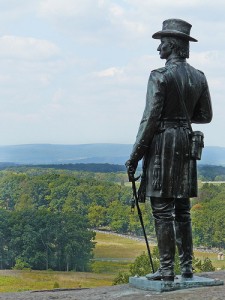Conference Preview: Civil War Battlefields – Imagining Possibilities after 150 Years
18 April 2012 – Cathy Stanton
Historians, preservationists, government officials, and elected representatives stand at a frontier of possibility and hope, or anguish and betrayal as the nation enters the sesquicentennial years of the Civil War. This proposed roundtable, in cooperation with audience members, dares to imagine how our Civil War battlefields should be managed for the next 150 years. These landscapes are laden with painful and hallowed memories. People whose ancestors fought in battles return to trace this connection. Military strategists study the decisions made to gain insights. Civil War enthusiasts tramp the land to relive the experiences. Preservationists call for protection of the parks and moderation of nearby development. Curious tourists bring their families and friends to share in the exploration and learn something new. Park neighbors and inholders sometimes display pride in their proximity to these battlefields and sometimes resist what they construe as infringing upon private property rights. People from different racial, ethnic, geographic, and socio-economic backgrounds ascribe an array of competing and oftentimes antagonistic feelings to these battlefields.
Interpretation has changed at these battlefields over the past ten years. Rather than just focusing on the military history, many sites have expanded interpretation to talk about the causes, the aftermath, the impact on families, and the connections between battles. Some enthusiasts take exception to this new emphasis, particularly when the interpretation says that slavery was the principal cause of the war.
These Civil War parks are also threatened by modern intrusions which gobble up historically significant land and encroach with developments. The parks sometimes offer the only viable recreational space in a community. Debates rage about restoring battle scenes or allowing a continuum of history.
Roundtable participants understand the history of Civil War battlefield preservation and most have on-the-job training in working with the public, whether visitors or neighbors, to present and manage these parks. Robert Sutton is NPS Chief Historian and former superintendent of Manassas National Battlefield Park. Ashley Whitehead is a ranger interpreter at Richmond National Battlefield Park, plus a doctoral student studying women and the Confederacy at West Virginia University. Peter Carmichael served for nine years as a seasonal at Fredericksburg and Spotsylvania National Military Park before moving into the academic world, where he now serves as Director of the Civil War Institute and Fluhrer Professor of Civil War Studies at Gettysburg College. Jimmy Price, formerly an assistant curator and education specialist for Henrico County, VA, works to preserve battlefields associated with the United States Colored Troops. Joan Zenzen, an independent historian, has written histories about the preservation and management of Manassas and Fredericksburg parks.
They would like to start the conversation now on the blog while looking forward to a free-flowing conversation at their Saturday 1:30 session. The session also will draw upon the recently released study Imperiled Promise, which examines how history is being done within the National Park Service, all with an aim towards developing strategies for a shared vision for the future of Civil War battlefield parks.





What about also attending the CW150 NCPH working group session tomorrow the 19th at 1 p.m. ? Some of these important issues will be partially covered